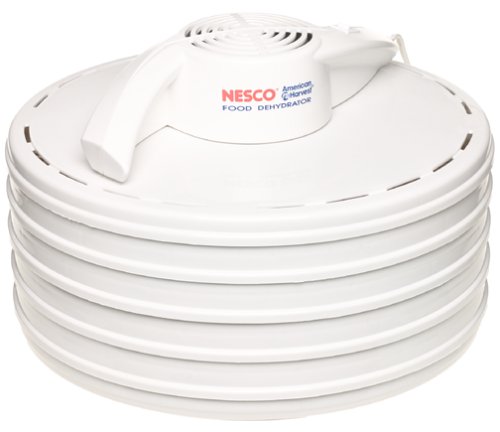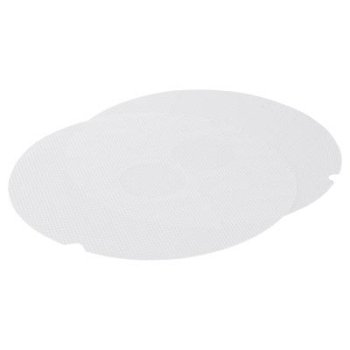 Drying apple slices in just five hours and beef jerky in seven, this 425-watt dehydrator is exceptionally fast for its price range. Its patented hot-air circulation system ensures not only speed but uniformity, so foods dry evenly. Each of the five trays is 13-1/2 inches in diameter and 1/2 inch deep (the plastic dehydrator stands 10 inches high), providing more than 12 square feet of tray space for drying lots of fruits, vegetables, herbs, and flowers at one time. Available separately is a two-tray accessory pack that expands the dehydrator to seven trays. Also available separately are accessories for drying fruit rolls, soups, and sauces and for making jerky from ground meat. Accompanying the dehydrator is a detailed instruction booklet with a drying-time chart for various foods and recipes for cooking with dried foods. --Fred Brack
Drying apple slices in just five hours and beef jerky in seven, this 425-watt dehydrator is exceptionally fast for its price range. Its patented hot-air circulation system ensures not only speed but uniformity, so foods dry evenly. Each of the five trays is 13-1/2 inches in diameter and 1/2 inch deep (the plastic dehydrator stands 10 inches high), providing more than 12 square feet of tray space for drying lots of fruits, vegetables, herbs, and flowers at one time. Available separately is a two-tray accessory pack that expands the dehydrator to seven trays. Also available separately are accessories for drying fruit rolls, soups, and sauces and for making jerky from ground meat. Accompanying the dehydrator is a detailed instruction booklet with a drying-time chart for various foods and recipes for cooking with dried foods. --Fred BrackBeef jerky is known to be the go-to product for people who need to bring along food, but lack refrigeration -- hikers, campers and hunters to name a few. With a food that seems to last forever and does not need to be refrigerated, it seems as if there is no such thing as beef jerky risks. However, as with any food preparation, there are some risks associated with the making of beef jerky.
See, when you really think about it, beef jerky is never cooked. That said, what then makes the meat safe to eat? Drying meat actually dates back thousands of years as a way to preserve portions of meat like buffalo and cattle that could not otherwise be saved. Think about it -- refrigeration just came into play this century, really. The principle behind the safe preservation of meat through drying is that the moisture is removed, meaning there is no longer a way for enzymes containing bacteria or fungus to react with the food. There are very few beef jerky risks when it comes to commercially-made beef jerky. This is because the United States Department of Agriculture (USDA) has set guidelines for beef jerky makers to follow, and like any manufacturer, they are monitored. But, when making at home beef jerky risks are more plausible. The reason for this is that the meat may not get to the right temperature before it is dried, which can cause some bacteria to be left behind. Meat should be heated to 160 F and poultry to 165 F before the dehydration process. Then follow the recipe instructions, which usually keep a dehydrator at 130-140 F. If the meat is not heated to par before the drying process starts, whether it is in a dehydrator or oven, the bacteria will become heat resistant. If bacteria are left behind on meat, salmonella and E. coli or other food born illnesses can infect those who eat the jerky.
Here are some tips directly from the USDA to reduce beef jerky risks when making at home:
Always wash hands thoroughly with soap and water before and after working with meat products.
Use clean equipment and utensils.
Keep meat and poultry refrigerated at 40 F or slightly below. Use or freeze ground beef and poultry within 2 days; whole red meats, within 3 to 5 days.
Defrost frozen meat in the refrigerator, not on the kitchen counter.
Marinate meat in the refrigerator. Don't save marinade to reuse. Marinades are used to tenderize and flavor the jerky before dehydrating it.
Steam or roast meat to 160 F and poultry to 165 F as measured with a food thermometer before dehydrating it.
Dry meats in a food dehydrator that has an adjustable temperature dial and will maintain a temperature of at least 130 to 140 F throughout the drying process.
For ground beef jerky prepared at home, safety concerns related to E. coli are minimized if the meat is precooked to 160 F prior to drying.
Homemade jerky can only be stored for one to two months, while commercially produced jerky can last a year.
Another beef jerky risk is the sodium content. Beef jerky is a good snack for those who want to eliminate carbs from their diet, and also some jerky is low in fat. However, most jerky is extremely high in sodium. A 30 g serving of beef jerky could contain more than 515 mg of sodium, which would be 21% of the recommended daily value. While salt is essential to our survival, too much sodium in a diet can cause high blood pressure. So, people who indulge in beef jerky often, as well as other salty foods may want to watch what they eat.
If you found this information on beef jerky risks useful, you'll want to read this article about alligator beef jerky.
dehydrator
